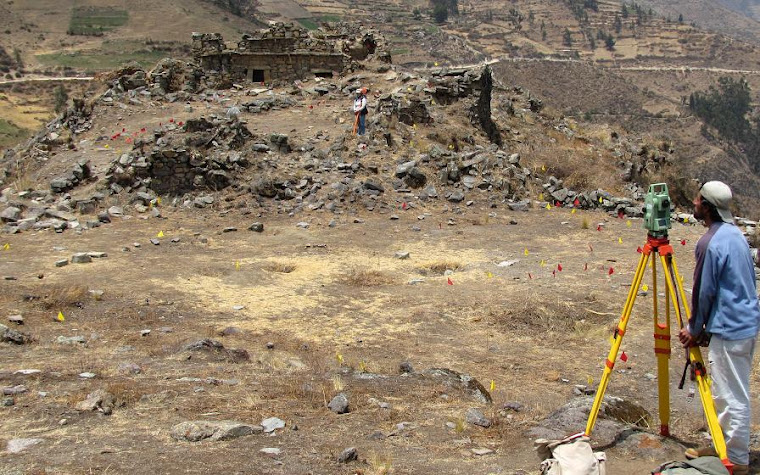A pesar de no haberse
comenzado formalmente la primera temporada de campo del PAHLA, sus marcos teóricos
ya fueron establecidos y expresados dentro de ésta ponencia (como habían sido
en la propuesta de la tésis doctoral para el Departamento de Antropología y el
Departamento de Historia de The University of Chicago en los fines del 2009). Por
varios años, debido a las características enumeradas abajo, Chase había hecho
hincápie en las teorías semióticas de “performance/performativity” (o “presentación
formal,” y actos “perlocucionarios” e “ilocucionarios”) para mejor entender wak’as
y las actividades asociadas con ellos. Fue en ésta ponencia que por primera vez
públicamente, Chase ofreció su definición de wak’as que desde ese entonces ha
aparecido en muchas de sus ponencias, conferencias, y está por salir en varias publicaciones.
El argumento básico es que “la ontología” de wak’as no se debe (ni se puede) considerar
aparte de cuestiones de temporalidad (especialmente el pasado), pues éstas
entidades eran íntegramente temporales, hasta “originarias” de nuevas épocas (“nuevos
pasados” colectivos), identidades, relaciones socio-políticas, y asentamientos.
Además, resisten la división semiótica entre “signifier” y “signified” que
tanto ha informado estudios de numina. Todo lo susodicho tiene que ver con la
realidad activa, “agency,” y las interacciones de estos seres sensatos (es
decir, wak’as, tanto unos con otros como con la gente), su materialidad
concreta y presencia imanente en el medio ambiente físico de las comunidades
del pasado, su rol en redes sociales y políticas, y mas que todo, su asociación
con orígenes–su poder generativo u originario del pasado y los presentes del
mundo andino prehispánico tardío.
Fue un gran honor participar
en ésta sesión con academicos tan reconocidos e importantes como Dra. Tamara L.
Bray (Wayne State University), Drs. Bruce Mannheim y Guillermo Salas Carreño
(University of Michigan), Dr. Steven Kosiba (ahora de University of Alabama), Dr.
Frank Meddens, Nick Branch, Millena Frouin, Dr. Colin McEwan, y Cirilo Vivanco
(de varias instituciones que incluyen The British Museum y la Pontificia
Universidad Católica del Perú), Dr. Jason Yaeger (Univesity of Texas San
Antonio), Dr. Izumi Shimada y Rafael Segura (Southern Illinois University),
Dra. Anita Cook (Catholic University), y el Dr. John Janusek (Vanderbilt
University). Agradezco ésta primera oportunidad pública de presentar las ideas
y propuestas que han dirigido gran parte de las investigaciones del PAHLA.
(Palabras claves: Arqueología
de Huarochirí, wak’as/huacas, reuniones de Society for American Archaeology, presentación
formal, actos perlocucionarios e ilocucionarios, “agency,” materialidad y la
presentación del pasado, los andes prehispánicos tardíos)
(English
translation)
Summary of the dissemination of PAHLA’s
work and findings, 2009-2013 (part 1 of 6).
In February, 2010, even before PAHLA was
settled in Peru, its Director, Zachary J. Chase was invited by Dr. Tamara Bray
to participate in the session “The Archaeology of Huacas: Exploring
the Materiality, Meaning, and Efficacy of Sacred Objects and Places in the
Andes,” in the SAA national meetings in St. Louis, Missouri (USA). Chase presented
“What is a huaca? When is a huaca?,” which (put simply) was an explication of
the revelations about temporality in the Andean past that are provided by an
understanding of wak’as (huacas), of their cultural ontology, and their historical
contexts.
Despite PAHLA’s first formal
field season not yet having commenced, its theoretical framework were already
established and expressed in this presentation (as they had been in the
dissertation proposal, defended before The University of Chicago’s Departments
of Anthropology and History towards the end of 2009). Based on characteristics
discussed below, Chase had long emphasized the importance of semiotic theories
of performance/performativity to better understand waka’s and the activities
associated with them. It was in this
presentation (SAA 2010) that Chase first publicly offered his definition of
waka’s which, since then has featured in many of his presentations, and appears
in several forthcoming publications.
The basic argument is that the
“ontology” of wak’as cannot be considered separately from matters of
temporality (in particular, the past), for wak’as were integrally temporal,
even “originary” of new eras (“new collective pasts”), identities,
socio-political relations, and in physical settlements. Moreover, wak’as defy
the sharp semiotic division between signifier and signified that has been so
influential in studies of numina. All of this has to do with the active
reality, agency, and the interactions of these sentient entities (i.e., wak’as
in interactions with one another and with peoples), their concrete materiality
and immanence in the physical environment of past communities, their role in
social and political networks, and above all, their association with origins–their
power that was generative of the past (or “originary”) and presents of the late
prehispanic Andean world.
It was a great honor to
participate in this session with such distinguished and important academics,
such as Dr. Tamara L. Bray (Wayne State University), Drs. Bruce Mannheim and
Guillermo Salas Carreño (University of Michigan), Dr. Steven Kosiba (currently
of University of Alabama), Dr. Frank Meddens, Nick Branch, Millena Frouin, Dr. Colin
McEwan, and Cirilo Vivanco (of several institutions, including The British
Museum and the Pontificia Universidad Católica del Perú), Dr. Jason Yaeger
(Univesity of Texas San Antonio), Dr. Izumi Shimada and Rafael Segura (Southern
Illinois University), Dr. Anita Cook (Catholic University), and Dr. John
Janusek (Vanderbilt University). I express gratitude for this first public
opportunity to present the ideas and proposals that have directed a large part
of PAHLA’s research.
(Keywords: Archaeology of
Huarochirí, wak’as/huacas, Society for American Archaeology meetings,
performance/performativity, agency, materiality, and the performance of the
past, late prehispanic Andes)


No hay comentarios:
Publicar un comentario